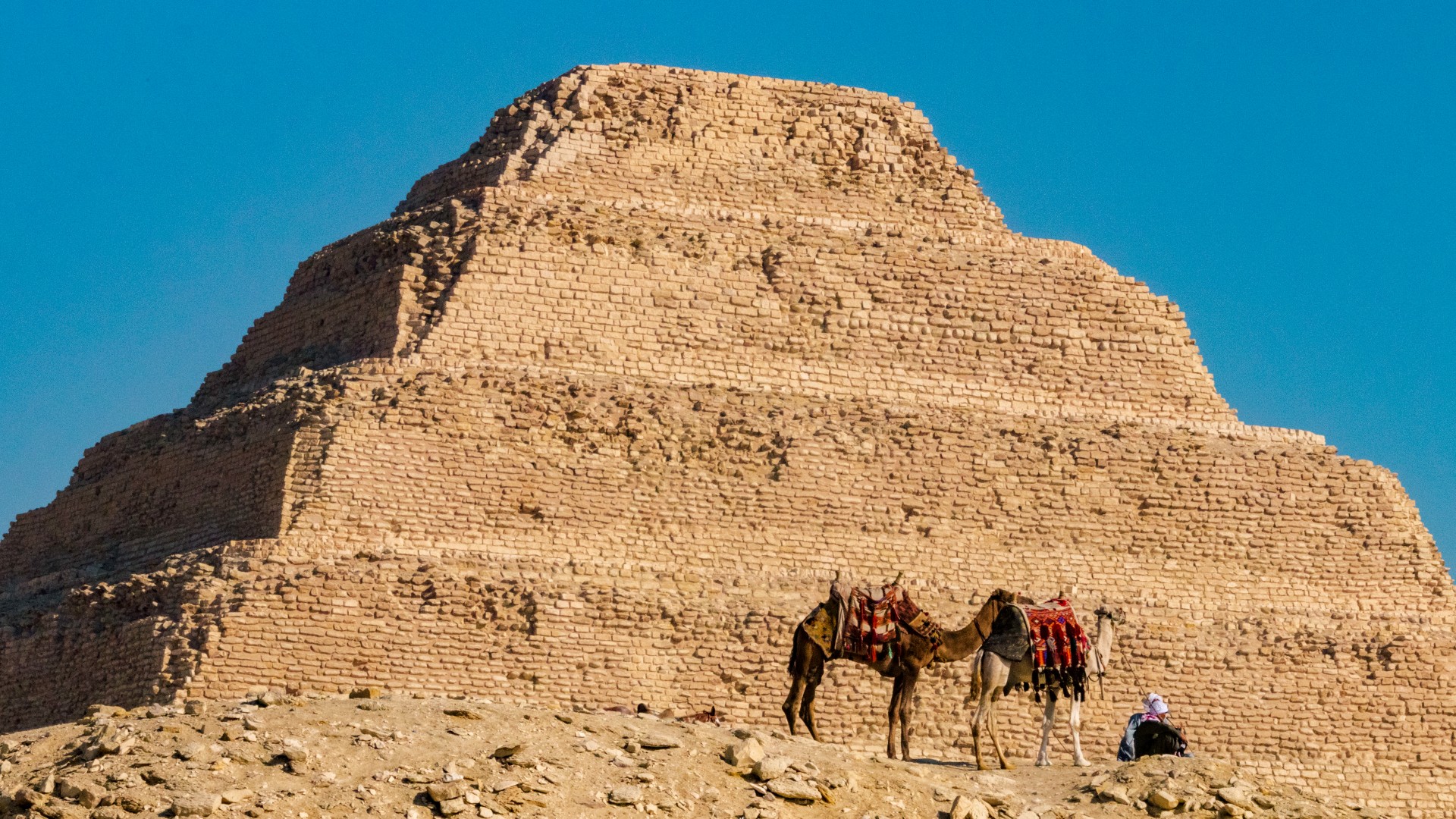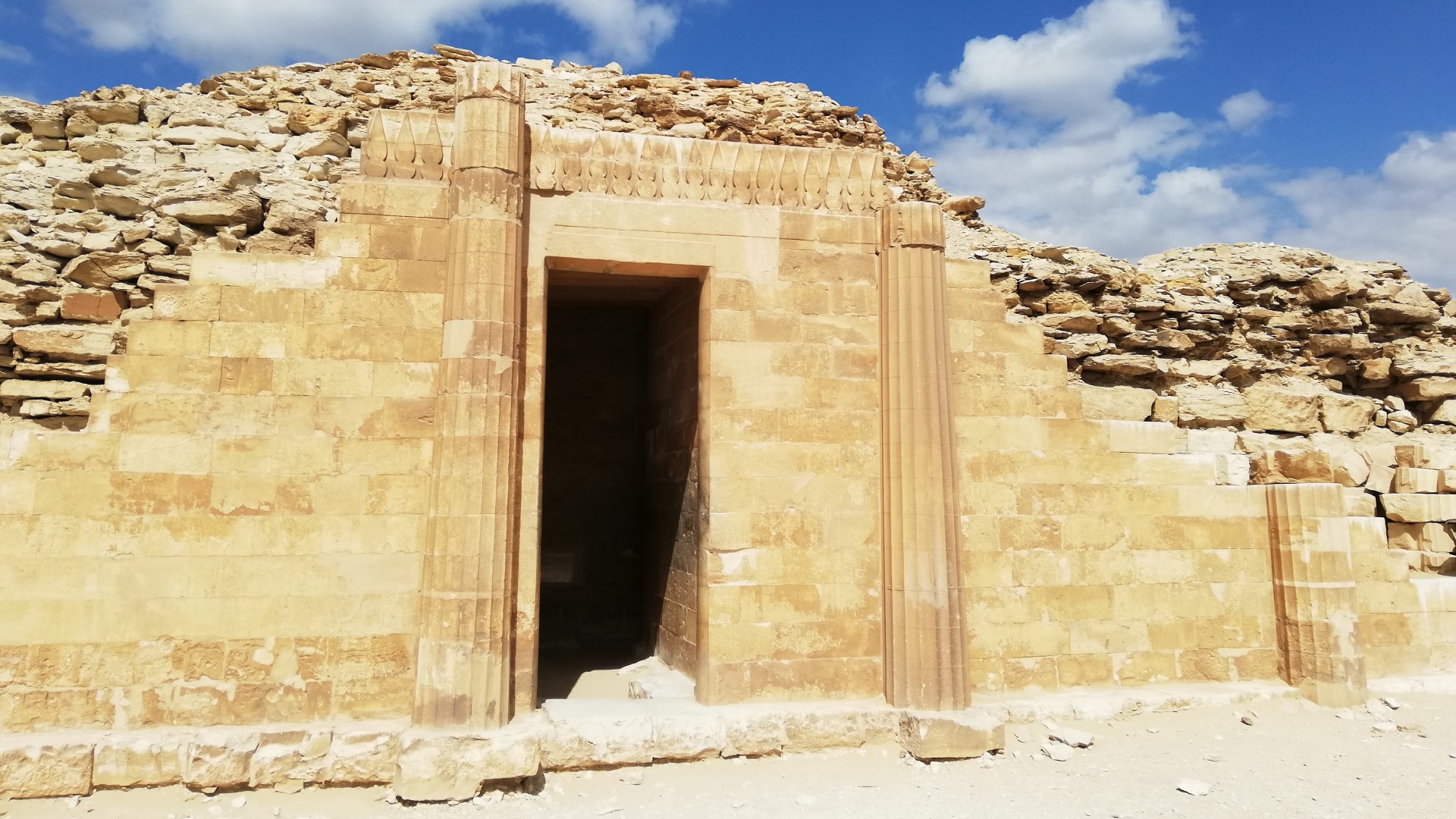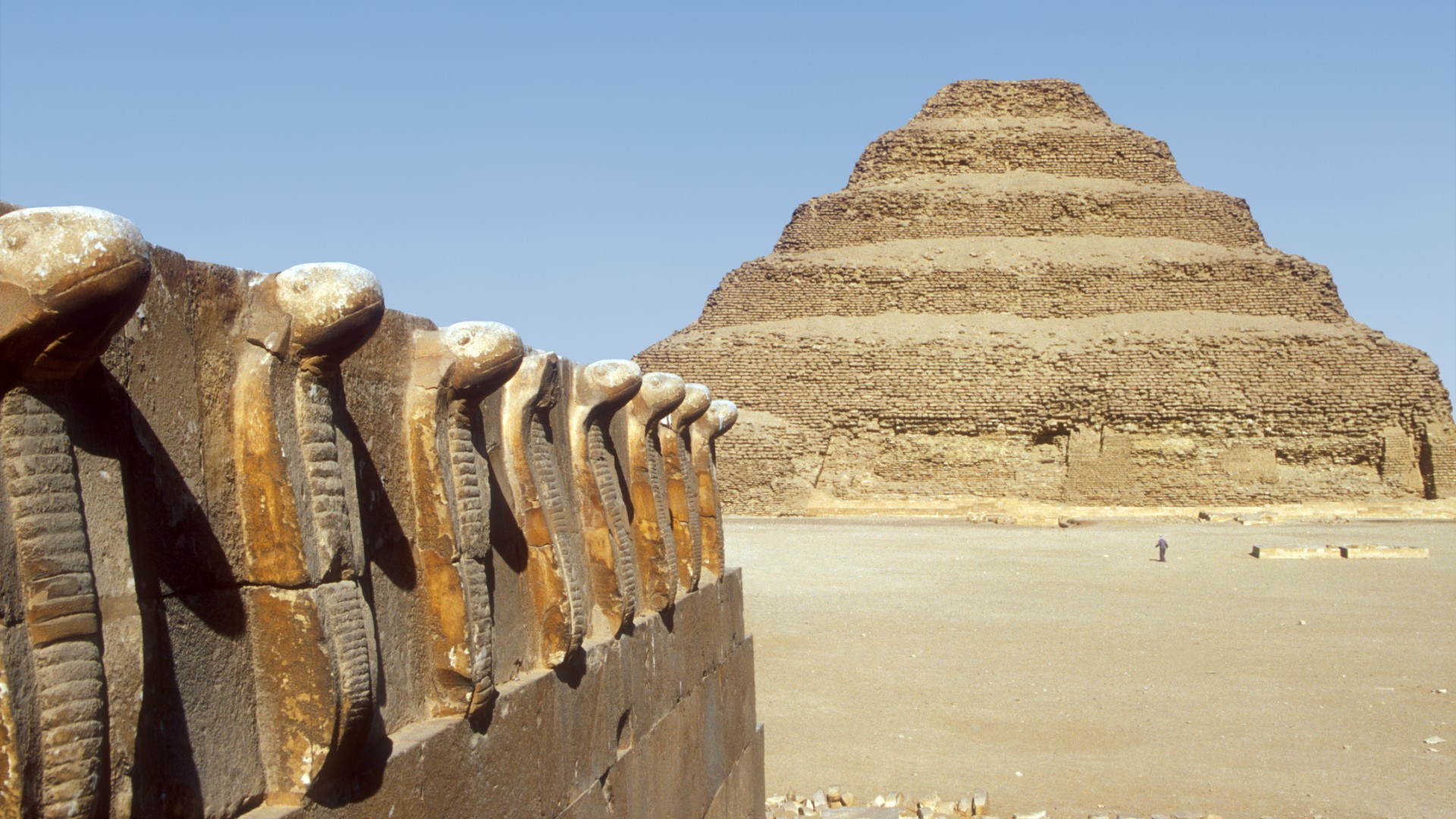Step Pyramid of Djoser: Egypt's first Pyramid
The Step Pyramid of Djoser was built about 4,700 years ago with six layers above ground and a series of tunnels below.

The Step Pyramid of Djoser, constructed at Saqqara about 4,700 years ago, was the first pyramid the Egyptians ever built.
The ancient Egyptian pharaoh that gave the pyramid its name, Djoser, sometimes spelled Zoser (though he was actually called Netjerykhet) ruled during Egypt's third dynasty. Scholars attribute the planning of the pyramid to Imhotep, a vizier who would later be deified for his accomplishments.
"Djoser is the name given to this king by New Kingdom visitors to the site over a thousand years later” wrote Egyptologist Mark Lehner in his book "The Complete Pyramids: Solving The Ancient Mysteries" (Thames & Hudson, 2008).
The pyramid started off as a mastaba tomb — a flat-roofed structure with sloping sides — and, through a series of expansions, evolved into a 197-foot-high (60 meters) pyramid, with six layers, one built on top of the other. The pyramid was constructed using 11.6 million cubic feet (330,400 cubic meters) of stone and clay. The tunnels beneath the pyramid form a labyrinth about 3.5 miles (5.5 kilometers) long. The pyramid was covered with tura limestone, most of which is gone today.
Better protection?
In earlier times, pharaohs were buried in smaller mastaba tombs, which robbers could reach by digging in from the top, Reg Clark, an Egyptologist, wrote in his book "Securing Eternity: Ancient Egyptian Tomb Protection from Prehistory to the Pyramids" (American University in Cairo Press, 2019). The Step Pyramid of Djoser, Clark wrote, would have made it almost impossible for a robber to reach the burial chamber by digging in from the top. Protection from grave robbers may be a reason why the ancient Egyptians built the step pyramid, Clark wrote.
While the step pyramid may have offered enhanced protection, people eventually broke into it, and today most of the burial goods, including the mummy of Djoser, are long gone.
Not every mummy has been looted from the tomb, however. Recent archaeological work revealed three mummies dating to the late period (ca. 712–332 B.C.) that were buried inside Djoser's burial chamber, according to a paper published in 2021 in the Journal of the General Union of Arab Archaeologists. This means that by the late period people had not only broken into the king's burial chamber but were burying more mummies inside of it.
Get the world’s most fascinating discoveries delivered straight to your inbox.
The Djoser complex
The pyramid is at the center of a complex 37 acres (15 hectares) in size. A recessed limestone wall surrounds the complex; fake doorways as well as the real colonnade entrances are embedded on the southeast side, wrote Lehner.
A temple lies on the north side of the pyramid along with a statue of the king. A small stone structure known as a "serdab" surrounds the statue, with the king's eyes peeking out through a hole in the serdab. To the south of the pyramid lies a great court, with an altar and stones identified as boundary markers, Lehner noted.
The builders placed a number of facade "dummy" buildings in the complex, including a series of chapels in the southeast as well as north and south pavilions on the east side of the pyramid. These structures would have served ritual purposes and, curiously, they appear to have been partly buried by their builders, wrote Lehner. In the southeast side of the complex, next to the dummy chapels, lies a court where the king could enact the Heb-Sed jubilee festival, presumably in the afterlife.
At the southern end of the complex lies the enigmatic "south tomb," with a chapel. It contains a series of tunnels that mimic those found beneath the pyramid itself.
"One room [in the south tomb] had carved limestone panels set into the walls depicting the pharaoh running the heb-sed race," wrote Aidan Dodson and Salima Ikram in their book "The Tomb in Ancient Egypt" (Thames & Hudson 2008). The heb-sed festival celebrated kingship, and during the festival the king would run around an open area. The south tomb may not have held any burials and its purpose is not clear, wrote Dodson, an Egyptology professor at the University of Bristol, and Ikram, an Egyptology professor at the American University in Cairo.
The complex is surrounded by a dry "moat" that is of varying depth and about 131 feet (40 m) wide, according to a study published in 2015 in the journal Archaeological Prospection. A survey of the moat revealed that it served as a "huge quarry for material used for construction of the Step Pyramid," the team wrote in their paper.
Who is buried in the Djoser pyramid?
Beneath the step pyramid winds a bewildering array of tunnels and chambers, the center of which is a 90-foot-deep (28 m) shaft that, at its bottom, contains the burial chamber of King Djoser. The mummy of King Djoser is gone, but conservation work in the burial chamber has revealed 32 fragments of the king's granite sarcophagus, Zahi Hawass, a former minister of antiquities in Egypt, wrote in his paper. From the remains, archaeologists estimate that the king's sarcophagus originally weighed 1.76 tons (1.6 metric tons).
The builders initially planned to decorate the ceiling with limestone blocks engraved with five pointed stars, creating the illusion of a star-filled sky. Archaeologists found blocks from this planned ceiling during conservation work, according to Hawass, but for reasons unknown, the builders scrapped this decoration, leaving a ceiling of plain granite.
Tunnels and underground 'palace'
Two passages lead underground and branch off in three directions. They contain three magazine (storage) galleries, a special tunnel for offerings, and an uncompleted chamber that may have formed an underground "palace" of sorts, albeit one for the afterlife.
The underground "palace" has three false doors containing stele, or stone carvings, showing the king engaged in rituals. The chamber is decorated with blue faience tiles, perhaps meant to imitate the reed matting found in the king's real-life palace in Memphis, Lehner noted in his paper. This subterranean chamber was hastily completed.
A tunnel on the east side of the pyramid contains 40,000 stone vessels, many of them belonging to the king's ancestors. Archaeologists have found human remains and sarcophagi nearby, including the hip bone of a woman who was around 18 years old when she died, Lehner noted. Some of the female remains dated to generations before Djoser's time, leaving a question as to who they were, according to Lehner's paper.
Modern-day conservation
From 2006 to 2020, Egypt led a project to conserve the pyramid, with some help from engineers from a British engineering company called Cintec. At one point during the conservation efforts, giant airbags were used to hold up the pyramid's roof while workers repaired the structure of the pyramid.
Some of the pyramid's blocks had become loose and were put back during conservation efforts.
"The team was able to collect all blocks that were loose under the sand, treated them immediately, and chose the best of them to be placed back onto the pyramid after filling the gaps with mortar," Hawass wrote. "The mortar that was used has the same ratio of limestone to sand used by the ancient Egyptians."
Mark of respect
The construction of the step pyramid marked the beginning of an ambitious pyramid-building program that would culminate with the Great Pyramid at Giza. Imhotep, the man credited with designing the step pyramid, would eventually be regarded as a god of sorts.
Egyptologist Marc Van De Mieroop wrote in his book "A History of Ancient Egypt" (Wiley-Blackwell, 2010), that King Djoser (Netjerykhet) gave Imhotep a rare honor, allowing his name and titles to be carved on the base of one the king's statues. One of his titles calls him "chief of sculptors," a phrase fitting for someone who designed the first Egyptian pyramid.
Djoser would also continue to be revered and, centuries after he died, officials still wanted to be buried near his step pyramid. In 2022, archaeologists found the tomb of one such official, named "Mehtjetju," by the step pyramid. He lived about 4,300 years ago, centuries after Djoser's reign.
One long-standing question is: Where is Imhotep buried? Given Imhotep's association with the step pyramid, Egyptologists suspect that he may be buried near his most well-known creation. One possibility is that Imhotep was buried beneath the step pyramid, an idea that future research at the pyramid will examine, Hawass wrote in his paper.
Additional resources
- You can learn more about how Egyptian pyramids were built in this Live Science article.
- The Egyptian Ministry of Tourism and Antiquities has more information about the step pyramid and how to visit it on their website.
- The ministry has also helped create a virtual tour of the step pyramid which can be seen here.
Bibliography
Clark, Reg "Securing Eternity: Ancient Egyptian Tomb Protection from Prehistory to the Pyramids" American University in Cairo Press, 2019
Dodson, A & Ikram, S "The Tomb in Ancient Egypt" Thames & Hudson 2008
Hawass, Zahi "The Discovery of the Sarcophagus of Djoser and the restoration of the step pyramid" Journal of the General Union of Arab Archaeologists, 2021
Lehner, Mark "The Complete Pyramids: Solving The Ancient Mysteries" Thames & Hudson, 2008
Van de Mieroop, Marc "A History of Ancient Egypt" Wiley-Blackwell, 2010
Welc et al "Western Section of the ‘Dry Moat' Channel Surrounding Step Pyramid Complex in Saqqara in the Light of Ground-penetrating Radar Prospection" Archaeological Prospection, 2015
Originally published on Live Science on Sept. 10, 2012 and updated on June 29, 2022.

Owen Jarus is a regular contributor to Live Science who writes about archaeology and humans' past. He has also written for The Independent (UK), The Canadian Press (CP) and The Associated Press (AP), among others. Owen has a bachelor of arts degree from the University of Toronto and a journalism degree from Ryerson University.




